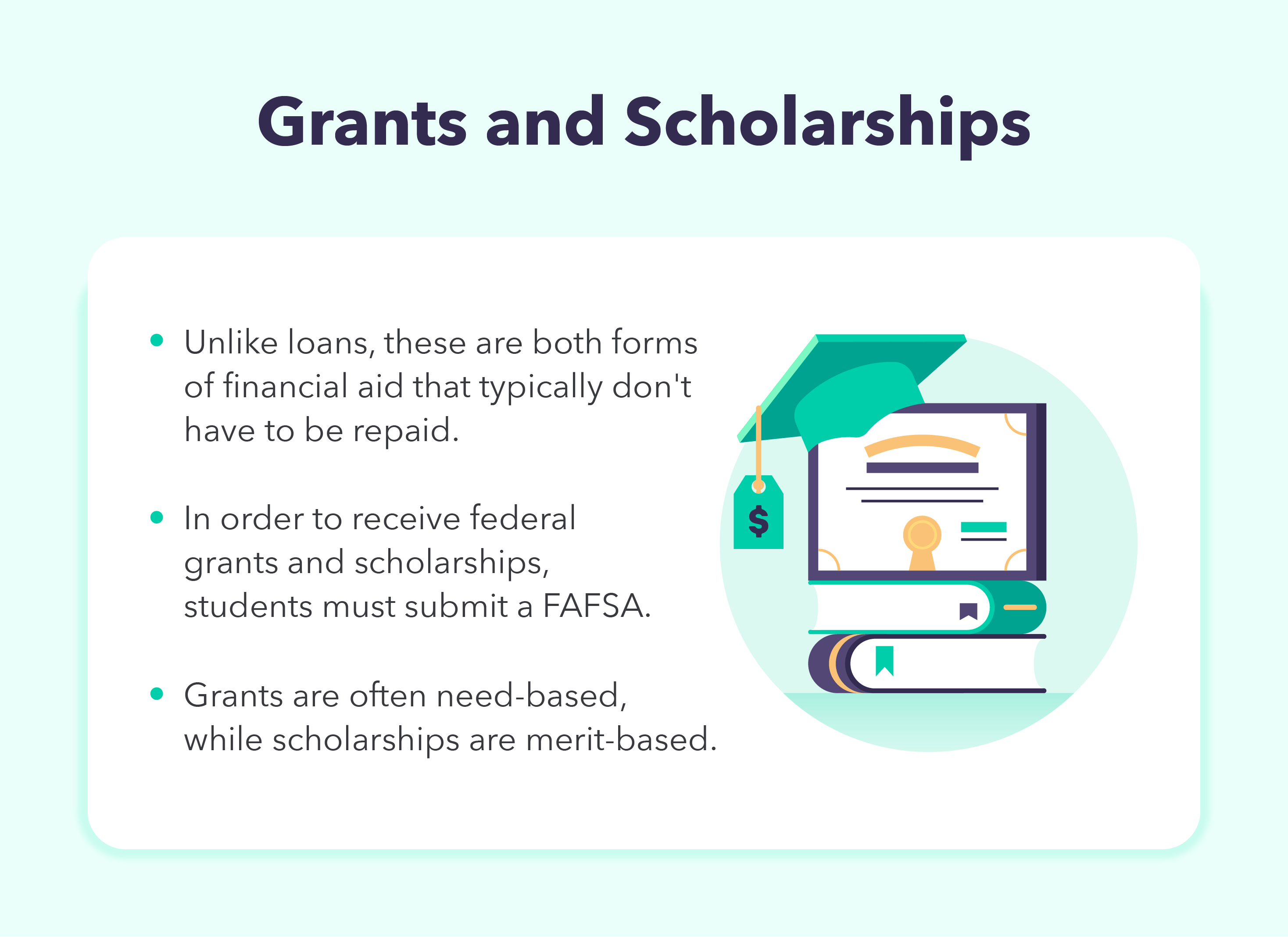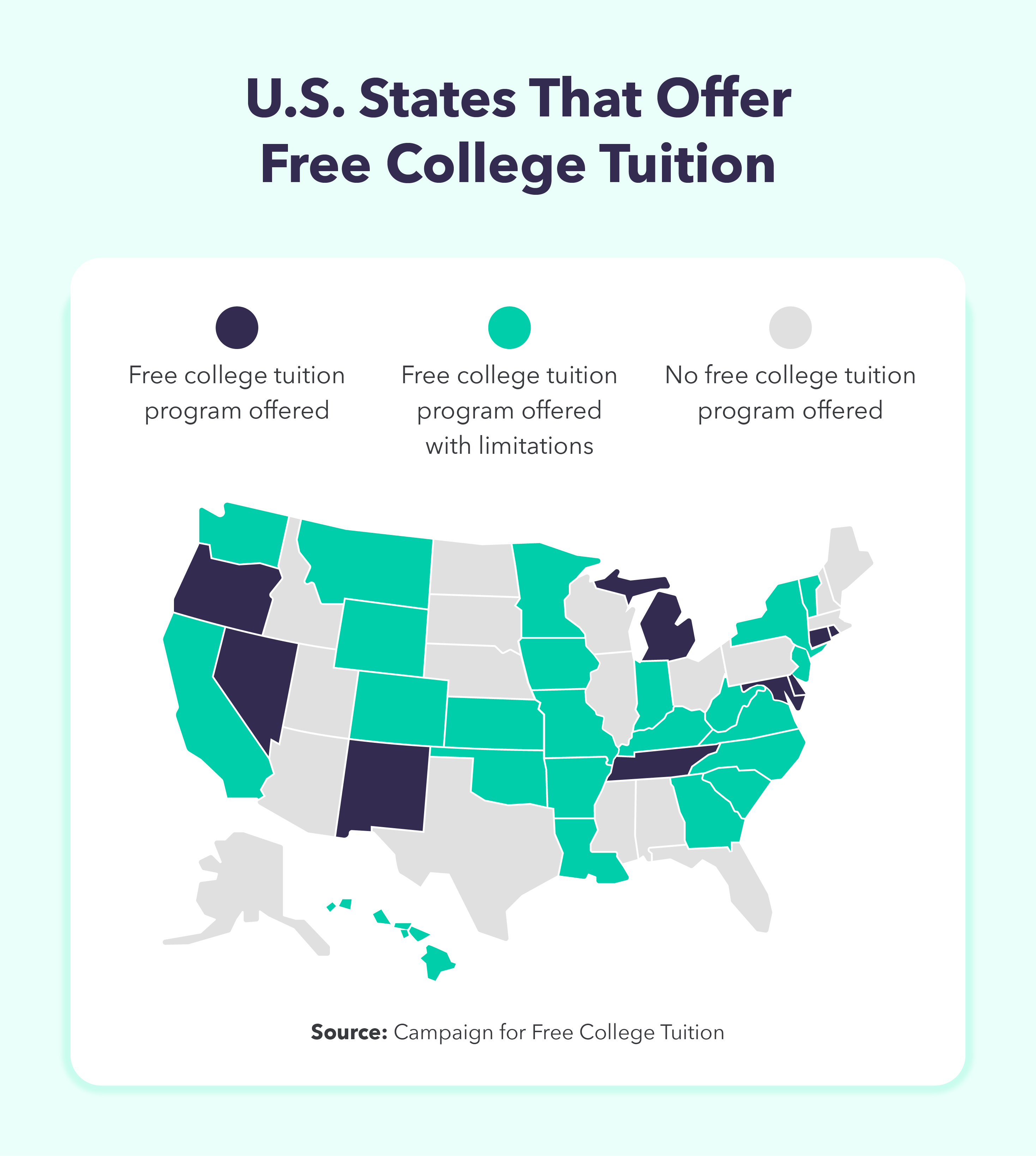College is an exciting time for students to live on their own, make new memories, and create lasting friendships. What’s not exciting is the debt you might inherit once you graduate. In the last decade, student loan debt increased by nearly 70 percent, with over 43 million students facing outstanding student loan debt.
What if there was a way you could get paid to go to college and avoid taking out any student loans? Sounds too good to be true, right? Well, we have twelve tactics for you to consider that just might help you go to college for free.
Keep reading for our favorite tips or jump to a specific tactic below to learn more!
- Submit a FAFSA
- Apply for Grants
- Research Various Scholarships
- Consider Community College
- Attend Tuition-Free College
- Check if You Qualify for Tax Breaks
- Become an RA
- Join the Military
- Get a Work-Study Job
- Seek Off-Campus Employment
- Serve in the AmeriCorps
- Ask If Your Employer Has Tuition Reimbursement
1. Submit a FAFSA
Applying for financial aid through your university or college is one of the first steps new students should take to pay for college. In order to qualify for financial aid, you must first fill out the Free Application for Federal Student Aid, commonly known as the FAFSA. Your completed FAFSA determines your level of financial need based on federal income tax returns and the amount of out-of-pocket money parents and students can pay toward college expenses each year.
FAFSAs must be submitted each year in order to qualify for financial aid and you can appeal them if financial circumstances change within that year. Financial aid is then awarded in the form of loans, grants, and work-study programs. Unlike grants or work-study money, you must repay loans with interest after graduation.
How much you could get paid: The amount of money you receive will depend on your level of financial need. You could potentially receive anywhere from $4,000 to tens of thousands of dollars in financial aid each year.
2. Apply for Grants
Grants are typically financial need-based, while scholarships are often merit-based. The most common federal grant students receive after submitting their FAFSA is the Pell Grant. The amount awarded changes each year, but during the 2022–2023 school year, full-time students received up to $6,895.
Talk to your college advisors and professors about what grants you might be eligible for. Remember that applying for grants and scholarships can be time-consuming, but many students will give up applying after the first year or lose their scholarship altogether, leaving the door open for you to be awarded that money!
How much you could get paid: The amount of money you receive in the form of grants will depend on how many you apply for — but the most common federal grant students receive, the Pell Grant, pays up to $6,895 depending on the year.

3. Research Various Scholarships
Think of scholarships as free money you just have to apply for. Scholarships and grants are both forms of financial aid that you typically don’t have to repay and can come from organizations, individuals, federal and state governments, employers, or schools to name a few.
Merit-based scholarships take into account your academic, athletic, or special talent abilities. Diversity scholarships are awarded to minority students who qualify. There are even disability scholarships awarded to people based on their needs. Each scholarship will have its own application and requirements. The key to winning scholarship money is having an organized system in place with time set aside to apply. Boost your earnings by finding lesser-known scholarships with fewer applicants that you can apply for.
How much you could get paid: You can expect to receive anywhere from a few hundred dollars to several thousand dollars for each scholarship you win. The more you apply for, the better your chances will be of racking up your earnings.
4. Consider Community College
Community college is an affordable option for students with tuition and fees, costing $3,800 on average compared to the $10,740 you can expect to pay each year at a four-year in-state college. You could even end up attending community college for free after submitting your FAFSA and being awarded a Pell Grant. In the 2021-2022 academic year, 33 percent of the federal aid received by community colleges was in the form of Pell Grants.
How much you could get paid: Each year, you have the opportunity to receive up to $6,895 from the federal Pell Grant which could cover all your costs for community college, ultimately paying you to go to college.
5. Attend Tuition-Free College
If you’re not picky about where you want to get your degree, you might consider enrolling in a community college with tuition-free education programs. Certain states started programs that offer free tuition for approved residents in the form of grant and scholarship payouts. Their goal is to give more people the opportunity to go to college by essentially paying their students to attend.

Based on the Campaign for Free College Tuition, there are 32 states in the U.S. with free college tuition programs in place.
- Arkansas — Arkansas Future Grant
- California — California College Promise
- Colorado — Colorado Opportunity Scholarship Initiative
- Connecticut — PACT
- Delaware — Student Excellence Equals Degree Scholarship
- Hawaii — Hawai’i Promise
- Indiana — 21st Century Scholarship
- Iowa — All Iowa Opportunity Scholarship
- Kansas — Kansas Promise Scholarship Act
- Kentucky — Work Ready Kentucky Scholarship
- Louisiana — Taylor Opportunity Program for Students
- Maryland — Maryland Community College Promise Scholarship
- Massachusetts — MASSGrant & MASSGrant Plus
- Michigan — Michigan Reconnect
- Minnesota — Minnesota Future Together Grants
- Missouri — A+ Scholarship
- Montana — Montana Promise Grant
- Nevada — Nevada Promise Scholarship
- New Jersey — Community College Opportunity Grant
- New Mexico — New Mexico Opportunity Scholarship
- New York — Excelsior Scholarship
- North Carolina — Longleaf Commitment Grant
- Oklahoma — Oklahoma’s Promise
- Oregon — Oregon Promise Grant
- Rhode Island — Rhode Island Promise
- South Carolina — Workforce Scholarships for the Future
- Tennessee — Tennessee Promise
- Vermont — VSAC Opportunity Grant
- Virginia — G3 Program
- Washington — College Bound Scholarship
- West Virginia — West Virginia Invests Grant Program
- Wyoming — Hathaway Scholarship
How much you could get paid: With the average community college tuition and fees costing $3,800, these states sponsor students by awarding grant and scholarship money to cover their total tuition costs.
6. Check if You Qualify for Tax Breaks
Tax credits help you afford the costs of higher education by reducing the amount of income tax you have to pay on your tax return. You might even get a refund after filing your taxes if your tax credits exceed the amount you owe in taxes. The American Opportunity Tax Credit, worth up to $2,500, and the Lifetime Learning Credit, worth up to $2,000, are both federal education tax breaks qualifying students can take.
You may also qualify for deductions following graduation, reducing the amount of your income that is subject to tax, and ultimately lowering the amount you owe in taxes. Even if you don’t itemize your deductions, you can claim the student loan interest deduction of up to $2,500 as an adjustment to income if you qualify.
How much you could get paid: You can receive up to $2,500 in tax credits just for attending college if you qualify.
7. Become an RA
If your college has on-campus housing, becoming a resident advisor (RA) is a great way to get paid to go to college. RAs enforce housing policies for students living on campus and push residents to succeed.
Most colleges provide RAs with free housing, meal plans, or stipends to go towards tuition and fees — total compensation averaging almost $35,000 a year. Check out this quick video that explains some of the pros and cons of being an RA.
How much you could get paid: On average, RAs get benefits, stipends, and incentives that total around $35,000 a year.
8. Join the Military

Serving your country by joining the U.S. Military is a rewarding opportunity that can pay off in more ways than one. Members, veterans, and their families may be eligible for education benefits.
- Military Tuition Assistance: This program can potentially fund the total cost of your college tuition and fees, paying up to $4,500 per year for eligible applicants and their spouses. Each branch of the military has its own requirements and application process.
- GI Bill: Implentend in 1944, the GI Bill helps qualifying veterans and their families pay for college, graduate school, or training programs. Under the Post-9/11 GI Bill, all tuition and fees for in-state students at public colleges or universities are fully covered, and it pays for up to $26,381.37 of private college tuition during the 2022 academic year. The U.S. Department of Veteran Affairs updates the payment rates every year.
How much you could get paid: Eligible members of the military receive $4,500 per year for school or professional training and could receive free college tuition at public in-state colleges.
9. Get a Work-Study Job
Applying for a Federal Work-Study job is a great way to help cover costs with part-time employment while you’re enrolled in school. The Federal Work-Study Program provides these programs through your school’s financial aid office. You can earn money to help pay for education expenses while serving the community or working for your college in your field of study. Some common work-study jobs include:
- Library attendant
- Tutoring assistant
- Researcher
- Tour guide
- Fitness center assistant
- Computer lab tech
- Local food bank helper
- Animal shelter assistant
How much you could get paid: At the minimum, you’ll receive the current federal minimum wage for the hours you work or even more depending on the skills required for your work-study job.
10. Seek Off-Campus Employment
Another great way to cover the costs of a college education is to apply for a local part-time job or start a side gig while you’re in school. Picking a job in the industry you want to work in when you graduate is also a great way to gain experience, learn more about what you’re majoring in, and network with other professionals.
According to the National Center for Education Statistics, on average, 74 percent of part-time students and 40 percent of full-time students have jobs. It’s important to remember to prioritize your education while working and avoid burnout to succeed both during college and after.
How much you could get paid: On average, off-campus jobs will pay college students a minimum of $10–$17 an hour based on experience and the industry. So, you can expect to make $3,600 a semester if you’re working 20 hours a week at $12 an hour.
11. Serve in the AmeriCorps
AmeriCorps is a network of over 1 million members and volunteers that work together to serve their communities. It’s a federal agency that anyone looking to create lasting change and make an impact can join. The AmeriCorps offers many benefits including a living allowance, loan deferment and interest forbearance, access to an alumni network, professional development opportunities, and money to go towards college or trade schools.
After serving in the AmeriCorps for about a year and enrolling in the National Service Trust, you will qualify for the Segal AmeriCorps Education Award, which you can use to pay your current tuition and fees for higher education or repay your existing student loans. Throughout the years, AmeriCorps members earned over 4 billion dollars in education awards to pay for college.
How much you could get paid: The Segal AmeriCorps Education Award is equal to the maximum amount awarded each year for the Pell Grant, which was $6,895 for the 2022–2023 school year.
12. Ask if Your Employer Has Tuition Reimbursement

If you already joined the workforce but are considering going back to school, ask your employer if they offer tuition reimbursement. Some companies partner with local colleges or universities to offer their employees compensation packages that include tuition assistance programs.
Each company policy will be different with set amounts or percentages they agree to pay, and requirements you must meet to remain eligible. Some employers will only pay for higher education that is relevant to your current line of work to benefit the company and reduce turnover. Remember that you still need to pay for your tuition costs up-front, even if your employer reimburses you.
How much you could get paid: Your employer will give you a set amount or percentage of your college tuition and fees that they are willing to pay.
Make a Plan to Attend College
There are ways you can get paid to go to school and possibly graduate with little to no debt, you just have to be willing to look for them. You shouldn’t write off college just because you think you can’t afford it. So, how can you avoid joining the many students who graduate with student loan debt and get paid to go to college?
Start making a plan ahead of time and create a custom budget to track all of your college expenses. If you do end up having to take out loans, don’t worry. We can help you find the student loan that’s right for you.
Sourcing:
- Percentage of student loan debt. Consumer Credit Outstanding (Levels) (September 2022)
- The number of students facing outstanding student loan debt. Federal Student Loan Portfolio (September 2022)
- Free Application for Federal Student Aid. FAFSA Application (September 2022)
- How to apply for the Pell Grant. Federal Pell Grant Application (September 2022)
- Costs of community college. AACC Fast Facts (March 2022)
- U.S. states with free college tuition options. Campaign for Free College Tuition (2022)
- Tax credits available. American Opportunity Tax Credit (December 2021)
- Education tax breaks. Lifetime Learning Credit (December 2021)
- Tax deductions for loans. Topic No. 456 Student Loan Interest Deduction (August 2022)
- Total compensation of an RA. Occupational Employment and Wage Statistics (May 2021)
- Video about the pros and cons of being an RA. Is Being a Resident Assistant Worth It? (October 2020)
- Military education benefits. Education Benefits for Service Members, Veterans, and Their Families (April 2022)
- Military education payment rates. VA Education and Training Rate Tables (September 2022)
- How to apply for a work-study. Federal Work-Study Jobs (September 2022)
- Current federal minimum wage. U.S. Department of Labor Minimum Wage (September 2022)
- Percentage of college students with jobs. College Student Employment (May 2022)
- AmeriCorps pays for college tuition and fees. Segal AmeriCorps Education Award (September 2022)
The post How To Get Paid To Go to College: 12 Tactics to Consider appeared first on MintLife Blog.
from MintLife Blog https://ift.tt/cX0HWPp
Comments
Post a Comment
We will appreciate it, if you leave a comment.